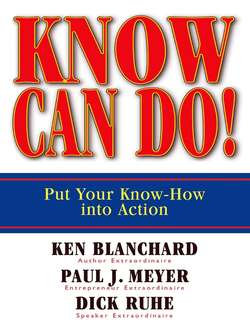Know Can Do! Put Your Know-How Into Action

Реклама. ООО «ЛитРес», ИНН: 7719571260.
Оглавление
Ken Blanchard. Know Can Do! Put Your Know-How Into Action
PREFACE
THE PROBLEM
THE MISSING LINK
THE POWER OF REPETITION
REASON 1: Information Overload
APPLYING THE LESS-MORE PHILOSOPHY
REASON 2: Negative Filtering
LISTENING WITH A POSITIVE MINDSET
USING GREEN LIGHT THINKING
REASON 3: Lack of Follow-Up
ACCENTUATING THE POSITIVE TO HELP PEOPLE WIN
PROVIDING MORE STRUCTURE, SUPPORT, AND ACCOUNTABILITY
EPILOGUE
ACKNOWLEDGMENTS
ABOUT THE AUTHORS
SERVICES AVAILABLE
Отрывок из книги
There once was a successful author who wrote about simple truths. His books were designed to help himself and others manage and motivate people in more effective ways.
Everyone who read his books loved his stories and messages. He sold millions of copies. Yet there was one thing that troubled him.
.....
Most people had a hard time answering that question. As a result, they often changed the subject by talking about another concept or some other book they were reading.
These kinds of interactions led the author to conclude that the gap between what people know – information they have picked up from books, audios, videos, and seminars – and what they do – how much they apply and use that knowledge – was significant. He found that was particularly true today with the incredible technology that makes knowledge easily accessible to everyone. People, he concluded, tend to spend considerably more time acquiring new information than developing strategies to use their newly acquired knowledge in their daily lives.
.....